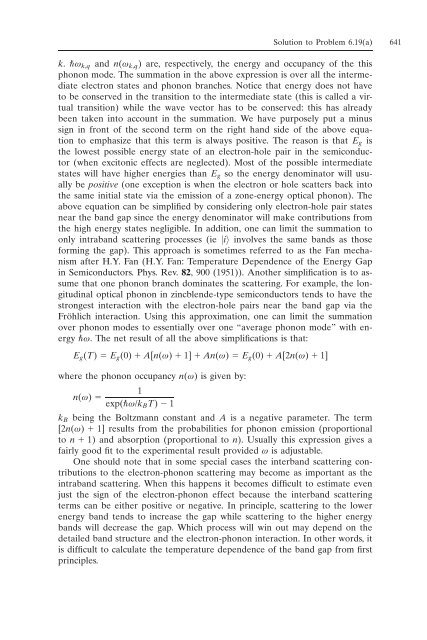10. Appendix
Create successful ePaper yourself
Turn your PDF publications into a flip-book with our unique Google optimized e-Paper software.
Solution to Problem 6.19(a) 641<br />
k. ˆk,q and n(ˆk,q) are, respectively, the energy and occupancy of the this<br />
phonon mode. The summation in the above expression is over all the intermediate<br />
electron states and phonon branches. Notice that energy does not have<br />
to be conserved in the transition to the intermediate state (this is called a virtual<br />
transition) while the wave vector has to be conserved: this has already<br />
been taken into account in the summation. We have purposely put a minus<br />
sign in front of the second term on the right hand side of the above equation<br />
to emphasize that this term is always positive. The reason is that Eg is<br />
the lowest possible energy state of an electron-hole pair in the semiconductor<br />
(when excitonic effects are neglected). Most of the possible intermediate<br />
states will have higher energies than Eg so the energy denominator will usually<br />
be positive (one exception is when the electron or hole scatters back into<br />
the same initial state via the emission of a zone-energy optical phonon). The<br />
above equation can be simplified by considering only electron-hole pair states<br />
near the band gap since the energy denominator will make contributions from<br />
the high energy states negligible. In addition, one can limit the summation to<br />
only intraband scattering processes (ie |i〉 involves the same bands as those<br />
forming the gap). This approach is sometimes referred to as the Fan mechanism<br />
after H.Y. Fan (H.Y. Fan: Temperature Dependence of the Energy Gap<br />
in Semiconductors. Phys. Rev. 82, 900 (1951)). Another simplification is to assume<br />
that one phonon branch dominates the scattering. For example, the longitudinal<br />
optical phonon in zincblende-type semiconductors tends to have the<br />
strongest interaction with the electron-hole pairs near the band gap via the<br />
Fröhlich interaction. Using this approximation, one can limit the summation<br />
over phonon modes to essentially over one “average phonon mode” with energy<br />
ˆ. The net result of all the above simplifications is that:<br />
Eg(T) Eg(0) A[n(ˆ) 1] An(ˆ) Eg(0) A[2n(ˆ) 1]<br />
where the phonon occupancy n(ˆ) is given by:<br />
1<br />
n(ˆ) <br />
exp(ˆ/kBT) 1<br />
kB being the Boltzmann constant and A is a negative parameter. The term<br />
[2n(ˆ) 1] results from the probabilities for phonon emission (proportional<br />
to n 1) and absorption (proportional to n). Usually this expression gives a<br />
fairly good fit to the experimental result provided ˆ is adjustable.<br />
One should note that in some special cases the interband scattering contributions<br />
to the electron-phonon scattering may become as important as the<br />
intraband scattering. When this happens it becomes difficult to estimate even<br />
just the sign of the electron-phonon effect because the interband scattering<br />
terms can be either positive or negative. In principle, scattering to the lower<br />
energy band tends to increase the gap while scattering to the higher energy<br />
bands will decrease the gap. Which process will win out may depend on the<br />
detailed band structure and the electron-phonon interaction. In other words, it<br />
is difficult to calculate the temperature dependence of the band gap from first<br />
principles.










